The cure is out there: Miniature space labs are leading to scientific breakthroughs
From attempts to crack the aging process to developing asthma medicine, the most innovative medical experiments are taking place these days in space
The ambitious Israeli startup has already launched four such boxes into space and on one night in late June, it appeared that it could finally carry out the fifth launch, following two delays in the past year and a failed launch a week earlier. The employees arrived with their families to watch the launch that was supposed to take place 10,000 kilometers away at the European Space Agency’s launch site in French Guiana, in South America.
 A rocket equipped with SpacePharma's devices. Photo: Arianespace
A rocket equipped with SpacePharma's devices. Photo: Arianespace Cookies and other assorted refreshments were brought out of the kitchen while the children (who should have been waking up to go to school in a few hours) inflated blue and white balloons in one of the labs. Before long, the open space resembled a political party headquarters on election night. At the same time in the Sheba Medical Center, which is leading one of the experiments, another event is being held in parallel. The guest of honor is the new Minister of Science Yizhar Shai.
But then, while the workers were still adjusting the monitors to view the live launch and the minister was starting on his speech, clouds started to cover the skies above the exotic beach town of Kourou, the Monsoon winds rising from the Atlantic Ocean disrupting the celebration. The launch was once again postponed.
The following day, all the workers gathered again, this time without their families, with the hope that the launch had already gone ahead. But then a further delay is announced. The message arrived just seven minutes before the planned time, again because of those darn Monsoon winds.
The senior managers, who hadn’t slept in two days, gather in the kitchen area and console themselves with the leftover cookies from the previous night. They try to figure out what to do and fret over the fate of the bacteria colony that is inside the mini-satellite, one of 53 that were loaded on the launch rocket. If the launch is delayed for too long, they will have no choice but to send the satellite back to the Netherlands, where the biological material is packed into the little box.
The original launch date for SpacePharma’s DIDO-3 satellite launch was September 2019. However, a technical malfunction in one of the rockets of the launching company led to it being scheduled for March 2020, but then Covid-19 happened and forced everything to be postponed until deep into Guiana’s rain season.
The Israeli and Italian space agencies spent 2 million euros on the project and the delays came at a price tag of $300,000 more. The next launch date was scheduled for August 17, nearly a year after the original date, with the hopes that the weather will ease off by then.
The Israeli development that freed up NASA’s bottleneck
Medical and physiological studies have been taking place in space since the 1950s when the Soviets sent Laika the dog into space to prove that living creatures can survive the conditions. In the 1970s NASA started using its space missions to host various experiments that required zero-gravity conditions, but due to the international space station’s monopoly on space experimentation and the requirement to cooperate with NASA, the space experiment market is nearly completely concentrated in the U.S.
The problem is that astronauts’ time up there is limited—every astronaut has a quota of tasks they need to complete while in space—and therefore very expensive. Moreover, astronauts aren’t necessarily scientists and must be trained in advance in how to carry out the hosted experiments. The result is a major bottleneck: in the past year 300 applications for space station experiments were submitted to the U.S. space agency, but it is only able to carry out 10% of the requests. This is where SpacePharma’s development enters the game, aiming to make those problems history.
SpacePharma is doing for the drug industry what the electronics industry did to old computers—it is converting massive equipment into small silicon plates. The wonders of nanotechnology were recruited to produce what they call “lab on chip”—a tiny, centimeters large 3D printed silicon chip that contains miniature test tubes connected by pipes. The chip is fed by a complete system, which stores the materials needed to conduct the experiments, including bacterial cultures, DNA molecules, skin tissues and chemicals, all in tiny doses of a few milliliters. The system also includes a set of sensors, including a microscope the size of a fingertip. The full system constantly monitors what takes place within the diminutive lab.
 An astronaut at the ISS holding one of SpacePharma's miniature labs. Photo: NASA
An astronaut at the ISS holding one of SpacePharma's miniature labs. Photo: NASA All of that baggage is placed in a three-liter box, roughly the size of a shoebox, with a simple USB plug at the bottom. All the astronauts at the space station need to do is connect up the box with the station’s computer and the experiment is set to go, managed by software that automates the process and controlled remotely by the folks at SpacePharma and Earthbound scientists. In the case of the current experiment, that keeps getting postponed, the astronauts won’t even have to plug anything in. The experiment will begin automatically as soon as the lab reaches space and six times a day, when the little satellite that carries it passes over the company’s communications center in Switzerland, the team members on Earth will be able to download data and send it new information. The scientists won’t even need a sophisticated control center as they will be able to do it all via a smartphone app.
SpacePharma’s first box was launched into space in 2017 aboard a nano-satellite. The experiment is over, but the satellite is still hovering in space until eventually it will fall into the atmosphere and burn up. Three other boxes that were sent up have since returned complete and one of them sits on display in the meeting room in Herzliya.
From a cancer research breakthrough to cracking the process of aging
Yossi Yamin, the CEO and founder of SpacePharma, founded the company seven years ago from his basement together with Ido Priel, who has since left the company. He is a retired lieutenant colonel , a former commander of the satellite unit of Israeli Military Intelligence, and has a bachelor of business administration from the University of Phoenix. In 2012, shortly after his discharge, he met with several of the heads of NASA who were visiting Israel and was inspired to found the company. According to Yamin, SpacePharm has raised $19 million from the likes of State of Mind Ventures, the Chief Scientist’s Office, the Israeli Space Agency, and the EU’s Horizon 2020 initiative.
 Yossi Yamin, CEO if SpacePharma. Amit Shaal
Yossi Yamin, CEO if SpacePharma. Amit Shaal Why does the drug industry even need experiments in space? The answer lies in crystals. The operating mechanism of many drugs is based on crystals—tiny solids that exist in liquids or gases, which due to their shape can easily penetrate or attach to the desired location in the body. The problem is that Earth’s gravity creates pressure on the crystals at the molecular level and warps them so that often the impact their original form would have had is “botched.”
In 200 Japanese researchers used zero-gravity to develop a drug to treat Duchenne muscular dystrophy (DMD). They shipped the protein that functions as the active ingredient of the drug to the space station and there, managed to produce a perfect crystal unwarped by gravity. The precision of the crystal together with the use of sophisticated sensory equipment enabled the scientists to see that a molecule of water that was in the active region of the protein disrupted its effectiveness and as a result, they were able to better design the protein’s structure.
Research in zero-gravity conditions has also enabled a breakthrough in cancer research. This is because when artificial cancer tumors are produced in the laboratory, they grow two-dimensionally because gravity subdues them. But in space, it is possible to produce three-dimensional tumors that better mimic the way tumors develop in the human body. For that reason, experiments performed on tumors produced in space have allowed researchers to test the efficacy of drugs that penetrate the tumor more reliably. American pharmaceutical giant Merk was assisted in an experiment in the process of protein formation, which took place at the International Space Station in the development of the popular drug Keytruda, which is used to treat several types of cancer.
The field of medical experimentation is space is mostly built around collaborations between the pharmaceutical giants and technology companies like Nanoracks and Techshot , which provide the resources for the trials. No other company, however, offers a solution like SpacePharma, which removes the responsibility for the experiment from the astronauts.
SpacePharma’s first experiments took place in 2017, testing the effect of zero-gravity on the formation of proteins in order to improve the use of inhaler medicines used by asthma patients. In the experiment, SpacePharma was able to form a crystal that in its pure form had the appearance of tiny needles that could lodge into an asthma patient’s throat and easily penetrate its tissue.
In SpacePharma’s later experiments, the company provided the platform, while the experiments were conducted by other research bodies. For example, in the long-delayed fifth launch, there are supposed to be four experiments resulting from collaborations between Israeli researchers and Italian universities. The first, done by researchers from Sheba Medical Center, is set to examine the process of developing the resistance of bacteria to antibiotics in the absence of gravity; the second from the Technion - Israel Institute of Technology, will monitor the rate at which the lysosome enzyme breaks down disease-causing bacterial residues, assuming that gravity slows the process down; The third, also by the Technion, will test how the protein albumin attaches to molecules in the blood as part of the activity of the immune system; while the fourth, conducted by the Hebrew University of Jerusalem, will test the aging process in human cells.
“When a healthy young astronaut returns to Earth from a three-month stretch at the space station, he or she is incapable of walking. When you examine their bodies you see that they have physiologically aged by 10 years,” explains Guy Samburski, the mission’s scientific manager and a former researcher at Teva. “They lose muscle mass and bone density, they experience hormonal changes and changes in their blood pressure. Anywhere you look you will find changes.”
 Astronauts operating in zero-gravity. Photo: NASA
Astronauts operating in zero-gravity. Photo: NASA A team led by Hebrew University’s Professor Itamar Willner is examining the mechanisms that cause rapid aging in space and discovered that the blame is linked to telomeres, a region of repetitive nucleotide sequences at each end of a chromosome. The telomeres are responsible for chromosome replication, which when it occurs ages our body's cell to a small degree. The theory is that in the absence of gravity to keep them in place, the telomeres loosen and that affects the replication process. As long as the monsoons don’t strike again and ruin the plans, the answer will be found in space.
From factories in space to storage facilities on the Moon
With all due respect for developing drugs, SpacePharm is already thinking of the future. After succeeding in carrying out experiments in space, the next natural step is to transition from experimentation to manufacturing. “We are examining other fields, such as food and agricultural technology, which have never entered space and we have only now begun to touch upon,” said Yamin. The conversation with him soars to the heights of imagination and the array of possibilities he suggests is vast. If we think of distant isolated locations, like deserts as suitable spots to store dangerous substances, perhaps the Moon is a better option? Yamin describes, in all seriousness, futuristic industrial zones that can house dangerous industries on the Moon or even Mars.
 Will the Mooon one day house a storage facility for hazardous materials? Photo: NASA
Will the Mooon one day house a storage facility for hazardous materials? Photo: NASA These are not pie-in-the-sky notions either. Just a few days prior to our meeting, it was reported that U.S.-based Mine in Space, which develops technology to mass produce solar panels and fibre optics in space, was acquired by AE Industrial Partners’ Redwire. In zero-gravity, materials can be made in their pure form, without all sorts of unnecessary molecular level blemishes, and thus produce fiber optics that can transmit much higher volumes than those that exist today, and solar panels that can generate more electricity from the sun.
SpacePharma, which has previously collaborated with Made in Space, wants a stake in this playground. Its next mission, scheduled for 2022, will shift from satellites to small production units that will operate in unmanned spacecrafts, blasting off with raw materials. The production process will be done in a space controlled remotely by SpacePharma personnel, and the finished products will land on Earth.
"The goal is to launch a soft drink containing an anti-aging polymer that will be produced in the unit within two years. At the same time, we are working on the production of crystals, antibodies for the pharmaceutical industry and even nerve cells and skin for transplants," Yamin said.
For that purpose, the company rented 100 kilograms on the Space Rider shuttle, the European Space Agency’s flagship project, that will be wholly dedicated to space production. Their share makes up eight percent of the shuttle’s total capacity, most of which was leased by electronics and optical companies.
“Mass production in space is the next challenge and it is much closer than we think,” Yamin said. It won’t be long before tiny spaceships will land in our homes delivering products we ordered directly from the factory in space.”



